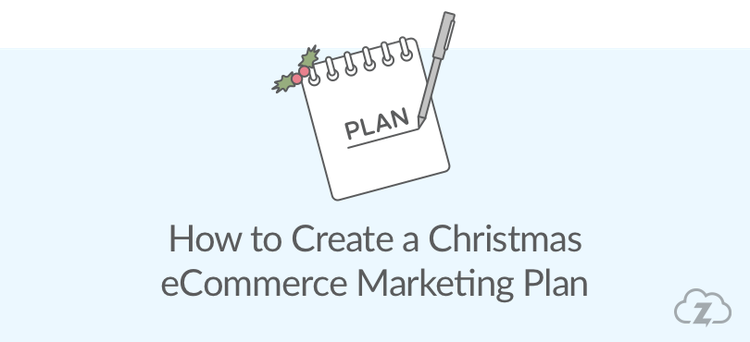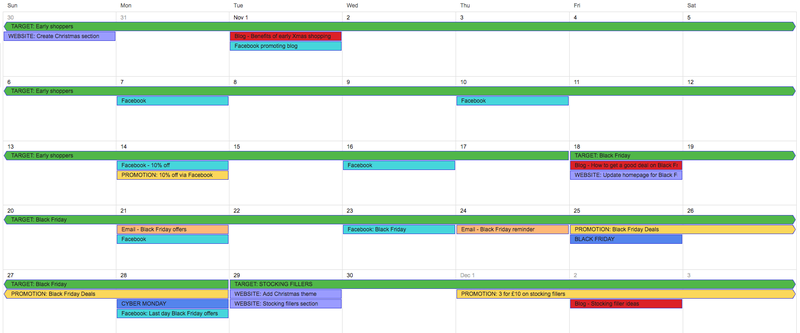How to create a Christmas ecommerce marketing plan

In the run up to Christmas, every retailer is competing to attract potential customers, so the earlier you start planning out your marketing the better chance you have of drawing more buyers to your online shop. We take you through what your Christmas ecommerce marketing plan should cover, and how you can go about creating a simple plan to promote your business.
What should your Christmas ecommerce marketing plan cover?
To make sure you’re properly prepared to take advantage of the busy Christmas period you need to plan every part of your marketing, right down to the last detail. Your ecommerce marketing plan should include every single thing you want to do: Any promotions or sales that you want to run, what emails you want to send and when, content you’re going to publish and website changes you need to make, as well as your social media plans, and any paid advertising.
How to create a Christmas ecommerce marketing plan
To start your plan you need to come up with an overall strategy of what your goals are in the lead up to Christmas, and how and what you want to communicate with your customers to achieve these. The best way to begin is to take a look at what you did last year - did you run any promotions? Did you send out emails? If so, when did you do it, should you have done it sooner or later? How successful were they?
You want to decide on the key ecommerce marketing actions you want to take, and when they will be most effective.
Audience
Take a look at the different customers you might want to target, for example; the early, organised shoppers, returning customers, shoppers looking for unique and personal gifts, last minute shoppers.
Channel
You then need to plan which marketing channels will be the most effective way of reaching your different audiences. Use emails to reach out to previous customers and encourage them to buy again, and publish blog posts about your more unusual products (with the right SEO keywords) to attract shoppers searching for something different. Paid advertising is a good way of drawing in new customers, so if you’re thinking of using something like Google AdWords work out your budget for it, then plan what advertising you can afford and for how long.
Timing
Now you know who you’re targeting and how you can work out the key dates to create your plan. The most important date will be your last order date for guaranteed delivery before Christmas. Working back from this you can plan out different targets for the coming months, these could include:
- Early shoppers - late October
- Black Friday/Cyber Monday shoppers - early November
- Stocking fillers and small gifts - November/December
- Stocking fillers and small gifts - November/December
- Last minute shoppers (offering discounts to reduce Christmas related stock) - second week of December
- Order deadlines - mid-December up to last order deadline.
Using these specific targets, timings,and channels, you can create a marketing calendar of the exact actions you’re going to take, and when you’re going to run discounts and promotions that fit in with them.
With a general time frame for your ecommerce marketing plan, you can decide when you need to make changes to your website, either to make the copy, images or theme relevant, or to add discounts.
You can then plan emails and blog posts that promote or relate to each theme. They should also guide your social media posts: Use Twitter, Facebook and Instagram to promote any offers, share your blog posts and any other related content. Promoting your discounts and deals regularly is the best way to make sure you reach potential customers.
Putting your marketing plan into action
With any marketing plan, it’s important to be flexible. While you want to stick to the plan as much as possible and not let yourself get behind, you do need to be able to move things around if something changes. You’ll also want to prepare some of your marketing in advance, plan and write your blog posts and emails now so that they’re ready to publish or send without taking too much time.

A simple way of planning out your ecommerce marketing plan is to use Google Calendar. You can add in the top level themes to cover several days or weeks, then include important dates and when you’re going to do each specific action - all of these can be colour coded to make it easy to see what’s going on.
Useful links
- Christmas ecommerce: 35 tips to increase conversions
- Top 10 methods to supercharge your Christmas sales
- AdWords basics: How to set up and use

